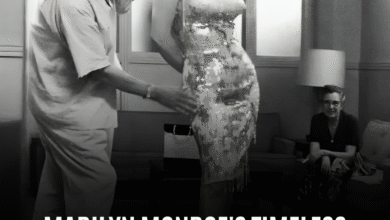The Secret Behind McGinnis’s ‘McGinnis Woman’ – Why His James Bond Posters Are More Than Just Art
OPINION: This article may contain commentary which reflects the author's opinion.
Robert E. McGinnis, a towering figure in American illustration, left an indelible mark on pop culture with his iconic contributions to the James Bond film franchise. Known for his evocative and photorealistic style, McGinnis’s work helped shape the visual landscape of the 007 films, cementing his legacy in both the art world and Hollywood. His extensive career spanned not only Bond posters but also a prolific portfolio of book covers and movie posters, establishing him as one of the most recognizable illustrators of the 20th century.
From Humble Beginnings to Artistic Icon
Born on February 3, 1926, in Cincinnati, Ohio, Robert McGinnis demonstrated an early passion for art, encouraged by his father, a construction worker, and his mother, who enrolled him in Saturday morning drawing classes at the Cincinnati Art Museum. By his teenage years, McGinnis was honing his craft further, securing an apprenticeship at Walt Disney Studios, marking a significant early step in his artistic journey. Although he left Ohio State University before graduating, McGinnis refined his skills at Jackson Grey Storey’s private art school in New York.
In the late 1940s, McGinnis began his professional career at a Cincinnati advertising art studio, but it wasn’t until he moved to New York in 1953 that his career truly took off. At Fredman Chaite Studios, he worked alongside a group of notable illustrators, immersing himself in the city’s vibrant artistic scene. A chance encounter with fellow artist Mitchell Hooks led him to Dell Publishing, where McGinnis launched a highly successful career illustrating paperback book covers. Over the next decade, he created over 1,200 covers, bringing to life the work of authors like Donald Westlake and Erle Stanley Gardner, with his art often seen as defining an era of bold, dramatic, and colorful storytelling.
McGinnis and James Bond: The Poster Art That Defined a Franchise
While McGinnis’s early work made him a sought-after book cover artist, his most famous contributions came in the form of James Bond movie posters. Beginning with Thunderball in 1965, McGinnis created a series of striking, dynamic posters that would come to define the visual identity of the Bond franchise. His illustrations were characterized by their portrayal of “The McGinnis Woman”—a confident, curvaceous figure often caught in the midst of thrilling action, and often presented in a sensual, semi-undressed manner.
These posters exuded glamour, danger, and excitement, encapsulating the essence of the James Bond films. For example, the Thunderball poster, featuring Sean Connery’s Bond smirking amidst the chaos of battle, became one of the most iconic images of the 007 series. His work on Diamonds Are Forever (1971), which features Bond with actresses Jill St. John and Lana Wood, remains one of his favorites. McGinnis’s style was not just about the allure of the female form, but about creating a vibrant energy that captured the action, romance, and exoticism of the Bond world.
Barbara Broccoli, the long-time James Bond producer, praised McGinnis for his ability to distill the essence of the films into his artwork. “He captured the wit, excitement, and adventure of Bond in a series of brushstrokes,” she said. McGinnis’s Bond posters have become synonymous with the franchise, appearing in countless art collections and auction houses. His work on You Only Live Twice, On Her Majesty’s Secret Service, and Live and Let Die further cemented his place as one of the most important contributors to the Bond visual canon.
A Broad Artistic Canvas Beyond Bond
While McGinnis will always be remembered for his work on the James Bond series, his artistic contributions spanned far beyond that. His first movie poster was for Breakfast at Tiffany’s (1961), which featured Audrey Hepburn in one of the most enduring images of her career, holding a cigarette holder and her cat. The poster was not only a breakthrough for McGinnis but also marked the beginning of his long and fruitful career in film poster illustration.
Over the years, McGinnis worked on over 40 movie posters, creating iconic artwork for films such as Barbarella, The Odd Couple, The Pink Panther, Sleeper, and The Incredibles. He was known for his meticulous attention to detail and his commitment to authenticity, often going so far as to request specific costumes or props to ensure the accuracy of his paintings. For example, for the film Arabesque, McGinnis insisted on having Sophia Loren’s tiger stripe dress to properly depict it in his artwork.
In addition to his movie poster work, McGinnis’s book covers were widely regarded as some of the best of their era. His covers for detective and crime novels, such as Shack Road Girl by Harry Whittington and Date with a Dead Man by Brett Halliday, brought a dynamic and cinematic quality to the medium, with his detailed illustrations adding a sense of drama and intrigue to the stories they accompanied.
A Legacy of Art and Influence
McGinnis’s career was not just about creating beautiful images but about shaping the visual culture of an era. His illustrations helped define the way audiences saw not only James Bond but also the broader world of cinema and literature in the mid-20th century. His work captured the energy, glamour, and intrigue of the films and stories he illustrated, and his legacy continues to influence artists and illustrators today.
McGinnis passed away on March 10, 2025, at the age of 99, leaving behind a body of work that defined an era. His death was noted in major publications, with The New York Times describing his work as “lusty, photorealistic artwork of curvaceous women” that captured the spirit of his time. His contributions to the world of illustration have solidified his place as a cultural icon whose legacy will continue to resonate with fans of the James Bond films and beyond.
In a world where digital artwork dominates, McGinnis’s hand-painted posters stand as a testament to the power of traditional illustration. His ability to combine action, romance, and visual storytelling made him an unrivaled talent in his field, and his work will continue to captivate audiences for generations to come.



